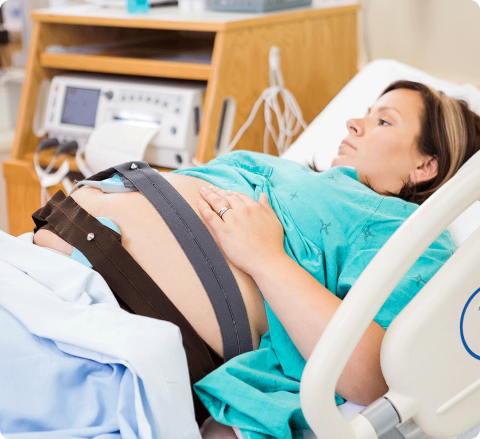Routine Intervention in Labour
Routine interventions in labour are the care practices which are offered to every labouring woman, depending upon the setting in which she has decided to give birth. These include: vaginal examinations, continuous electronic fetal monitoring, lying down on the bed and episiotomy. Many of these procedures interfere with the labour efficiency and with a woman's ability to manage the intensity of her labour. This is not necessary a trade off in order to ensure that the mother and baby remain safe, as many routine interventions have not been shown to provide any benefit to the mother or baby.
We would all ideally like to have individualised care during the birth of our baby and have our needs and the needs of our baby placed front and centre in all decisions. The reality is that there is often a tension between a woman's need for individualised care in labour and the everyday customs and policies of the hospital or caregiver she has chosen to look after her. Unfortunately, many of the procedures which are offered routinely to women during labour, actually interfere with the body's ability to maintain really good labour contractions and with the woman's ability to manage their intensity.
If a woman's labour becomes slow due to the impact of these interventions or her ability to work with the pain of labour is diminished, then there is an increased likelihood that she will experience further complications or intervention. Some interventions may be seen as necessary in order to keep the mother and baby safe during the birth. In this situation we might see any negative impact upon the labour as a necessary trade off. However, many of the routine interventions offered during labour and birth, have not been shown by research to provide any benefit to the mother and baby.
This means that even though these interventions are negatively impacting the quality of the woman's experience of labour and the safety of the labour itself, they have not been shown to benefit neither the woman nor the baby.
Research shows that the following models of care or procedures have no benefit to the mother and baby and are associated with the following increases risks:
Recording a woman's progress in labour using a Partogram (Lavender et al. 2013).
A Partogram is a graph of a woman's progress in labour made by the midwife by using results from Abdominal Palpation and Vaginal examinations.
- increased the risk of being diagnosed with a prolonged labour and experiencing further intervention to address the diagnosis (Albers 1999, Cesario 2004 and Zhang et al. 2002, Walsh 2009, Walsh 2012, Lavender et al. 2013)
Offering vaginal examinations during labour (Downe et al.2013).
- see above
- increases emotional distress (NICE 2007, Devane. 1996, Lewin et al. 2005).
- increases the risk of infection to the baby (Lumbiganon et al. 2004, Seaward et al. 1997 and Hannah et al. 2000).
Monitoring the baby's heart rate with the doppler in low risk women (Alfirevic et al. 2013).
- routine doppler ultrasound is not recommended in low-risk pregnancies (NICE 2007:35)
Continuous electronic fetal monitoring – the belt monitors (Alfirevic et al. 2013).
- More likely to have minor obstetric interventions like epidural analgesia, ongoing continuous electronic fetal monitoring and fetal blood sampling for fetal distress (Blix 2005);
- Increases the risk of a vacuum or forceps assisted birth (Alfirevic et al. 2013);
- increases the risk of having a caesarean (Alfirevic et al. 2013);
Artificially breaking the waters (Smyth et al.2013).
Lying down during labour or birth (Lawrence et al.2013).
- increases the duration of labour (Lawrence et al.2013).
- increases the risk of caesarean birth (Lawrence et al.2013).
- increases the need for epidural (Lawrence et al.2013).
- increases risk of significant bleeding (Terry et al. 2006)
- increases risk of anal sphincter tear (Dudding et al. 2008)
Coach pushing for the birth when the woman does not have an epidural in place.
- Does not speed up the birth (Parnell et al. 1993, Chang et al.2010, Simpson and James. 2005, Yildirum and Beji 2008).
- Increases the risk of pelviic floor damage (Fraser et al. 2000, Schaffer et al.2005, Handa et al.1996) ).
Cutting an episiotomy for any reason other than the baby being distressed (Dannecker et al. 2004)
- increases the risk of significant pelvic floor damage (Carroli and Mignini 2009, DiPiazza et al. 2006, Gerdin et al. 2007, Altman et al.2007, Sartore et al.2004, Bick et al. 2008, Dannecker et al. 2004).
Giving low risk women an injection of artificial oxytocin to deliver the placenta (Begley at al.2011).
- increases blood pressure;
- increases after pains;
- increases the risk of nausea and vomiting;
- increases the use of medication for pain relief in the postnatal period;
- increases the number of women re-admitted to hospital with vaginal bleeding (Begley at al. 2011).
PPA campaigns to support maternity services to ensure that their clinical guidelines reflect the best evidence available and that midwives and doctors present this information to women so that they can make informed decisions about their care.
References
- Albers, L. (1999) the duration of labour in healthy women. Journal of Perinatology. 19(2): 114-19.
- Alfirevic, Z., Devane, D., Gyte, G.M.L. (2013), Continuous cardiotocography (CTG) as a form of electronic fetal monitoring (EFM) for fetal assessment during labour. Editorial Group: Cochrane Pregnancy and Childbirth Group. Published Online: 31 MAY 2013 available at http://onlinelibrary.wiley.com/doi/10.1002/14651858.CD006066.pub2/abstract [accessed on 15 November 2013].
- Altman, D., Ragnar, I. and Ekstrom, A. (2007). Anal sphincter lacerations and upright delivery postures: a risk analysis from a randomized controlled trial. International Urogynecology Journal, 18: 141-6.
- Begley CM, Gyte GML, Murphy DJ, et al. (2011) Active versus expectant management for women in the third stage of labour. Cochrane Database of Systematic Reviews, Issue 11. Chichester: John Wiley and Sons
- Bick, D., MacArthur, C. and Winter. H. (2008) Postnatal Care: Evidence and Guidelines for Management, 2nd edn. London: Churchill Livingstone.
- Blix, E., Reinar, L. and Klovning, A. and Oian, P. (2008) Prognostic value of the admission test and its effectiveness compared with auscultation only: a systematic review. BJOG, 112: 1595-604.
- Caldeyro-Barcia, R. (1979) Influence of maternal bearing down efforts during second stage on fetal well-being. Birth and Family Journal, 6(1): 7-13.
- Carroli, G. and Mignini, L. (2009) Episiotomy for vaginal birth. (Cochrane Review). In The Cochrane Library, Issue 1. Chichester: John Wiley & Sons, Ltd.
- Cesario, S. (2004) Re-evaluation of Freidman’s labour curve: a pilot study. Journal of Obstetrics, Gynecology and Neonatal Nursing, 33:713-22.
- Chang, S., Chou, M., Lin, L., Lin, Y. and Kuo, S. (2010) Effects of a pushing intervention on pain, fatigue and birthing experience amoung Taiwanese women during the second stage of labour. Midwifery, doi:10.1016/j.midw.2010.08.009.
- Dannecker, C., Hillemanns, P. Strauss, A. et al. (2004) Episiotomy and perineal tears presumed to be imminent: randomised controlled trial. Acta Obstetrics et Gynecologica Scandinavia, 83: 364-8.
- Devane, D. (1996) Sexuality and Midwifery. British Journal of Midwifery, 4(8): 413-20.
- DiPiazza, D., Richter, H., Chapman, V., Cliver, S., Neely, C., Chen, C. and Burgio, K. (2006) Risk factors for anal sphincter tear in multiparas. Obstetrics and Gynecology, 107(6): 1233-6.
- Downe S, Gyte GM, Dahlen HG, Singata M. (2013). Routine vaginal examinations for assessing progress of labour to improve outcomes for women and babies at term. Cochrane Database Syst Rev. 2013 Jul 15;7:CD010088. doi: 10.1002/14651858.CD010088.pub2.
- Fraser, W., Marcoux, S., Krauss, I. et al. (2000) Multi-centre, randomised controlled trial of delayed pushing for nulliparous women in the second stage of labour with continuous epidural analgesia. American Journal of Obstetrics and Gynecology, 182: 1165-72.
- Gerdin E, Sverrisdottir G, et al. (2007). The role of maternal age and episiotomy in the risk of anal sphincter tears during childbirth. Aust N Z J Obstet Gynaecol 47 (4): 286-90.
- Handa, V., Harris, T. and Ostergard, D. (1996) Protecting the pelvic floor: obstetric management to prevent incontinence and pelvic organ collapse. Obstetric and Gynecology, 88: 470-8.
- Hannah M.E., Hannah, W.I., Hewson, S.A., et al. (2000) Planned caesarean section versus planned vaginal birth for breech presentation at term: a randomised multicentre trial. Lancet 2000; 256: 1375-83.
- Hodnett ED, Downe S, Walsh D. (2012). Alternative versus conventional institutional settings for birth. Cochrane Database of Systematic Reviews 2012, Issue 8. Art. No.: CD000012. DOI: 10.1002/14651858.CD000012.pub4.
- Johnstone, F., Aboelmagd, M. and Harouny, A. (1987) Maternal position in the second stage of labour and fetal acid base status. British Journal of Obstetrics and Gynaecology, 94(8): 753-7.
- Lavender, T., Hart, A., Smyth, R. (2013). Effect of partogram use on outcomes for women in spontaneous labour at term. Editorial Group: Cochrane Pregnancy and Childbirth Group. Published Online: 10 JUL 2013 at :http://onlinelibrary.wiley.com/doi/10.1002/14651858.CD005461.pub4/abstract . DOI:10.1002/14651858.CD005461.pub4
- Lawrence, A., Lewis, L., Hofmeyr, G.J., Styles, C. (2013). Maternal positions and mobility during first stage labour. Editorial Group:Cochrane Pregnancy and Childbirth Group. Available online at http://onlinelibrary.wiley.com/doi/10.1002/14651858.CD003934.pub4/abstract [Accessed on 1 April 2014]
- Lewin, D., Fearon, B., Hemmings, V., & Johnson, G. (2005). Women's experiences of vaginal examination in labour. Midwifery, 21, 267-277.
- Lumbiganon, P., Thinkhamrop, J., Thinkhamrop, B., & Tolosa, J. E. (2004). Vaginal chlorhexidine during labour for preventing maternal and neonatal infections (excluding Group B Streptococcal and HIV). Cochrane Database of Systematic Reviews (4). The Cochrane Collaboration retrieved 17/04/09.
- NICE (2007) Intrapartum care: Care of healthy women and their babies during childbirth. Available online at http://www.nice.org.uk/nicemedia/pdf/IPCNICEguidance.pdf [accessed on 6 September 2013]
- Parnell, C., Langhoff-Roos, J., Iverson, R. et al. (1993) Pushing method in the explusive phase of labour: a randomised trial. Acta Obstetrica et Gynecologica Scandinavia, 72(1): 31-5.
- Sandall, J., Soltani, H., Gates, S. et al (2013). Midwife-led continuity models versus other models of care for childbearing women. Cochrane Database of Systematic Reviews, Issue 8. Available online at http://onlinelibrary.wiley.com/doi/10.1002/14651858.CD004667.pub3/abstract [accessed on 31 October 2013].
- Sartore, A., De Seta, F., Maso, G. et al. (2004) The effects of mediolateral episiotomy on pelvic floor function after vaginal delivery. Obstetrics and Gynecology, 103: 669-73.
- Schaffer, J., Bloom, S., Casey, B. et al. (2005) A randomised trial of the effect of coached vs uncoached maternal pushing during the second stage of labor on postpartum pelvic floor structure and function. American Journal of Obstetrics and Gynecology, 192: 1692-6.
- Seaward PG, Hannah ME, Myhr TL, et al. International Multicentre Term Prelabor Rupture of Membranes Study: evaluation of predictors of clinical chorioamnionitis and postpartum fever in patients with prelabor rupture of membranes at term. American Journal of Obstetrics and Gynecology. 1997;177(5):1024–9.
- Simpson, K. and James, D. (2005) Effects of immediate versus delayed pushing during second-stage labour on fetal well being. Nursing Reseach, 54(3): 149-57.
- Smyth, M.D., Markham, C., Dowswell, T. (2013). Amniotomy for shortening spontaneous labour. Editorial Group: Cochrane Pregnancy and Childbirth Group. Published Online: 18 JUN 2013, available at http://onlinelibrary.wiley.com/doi/10.1002/14651858.CD006167.pub4/abstract [accessed on 15 November 2013]. DOI: 10.1002/14651858.CD006167.pub4.
- Walsh, Denis (2012) Evidence and Skills for Normal Labour and Birth – A Guide for Midwives. Second Edition. New York: Routledge.
- Walsh, T. (2009) Exploring the effects of hospital admission on contraction patterns and labour outcomes using women’s perception of events. Midwifery, 25: 242-52.
- Yildirim, G. and Beji, N. (2008) Effects of pushing techniques in birth on mother and fetus: a randomised study. Birth, 35(1): 25-30.
- Zhang, J., Troendle, J. and Yancey, M. (2002) Reassessing the labour curve. American Journal of Obstetrics and Gynecology, 187: 824-8.
QUICK FACTS
Vaginal Exams
do not protect the baby or improve the outcome of the birth.
Belt Monitors
do not protect the baby during labour or improve the outcomes for the baby, with the exception of a halving of neonatal seizures which in themselves are not harmful.
Episiotomy
does not protect the mother from significant tearing and has only been shown to provide benefit when performed because the baby is distressed and needs to be born.

